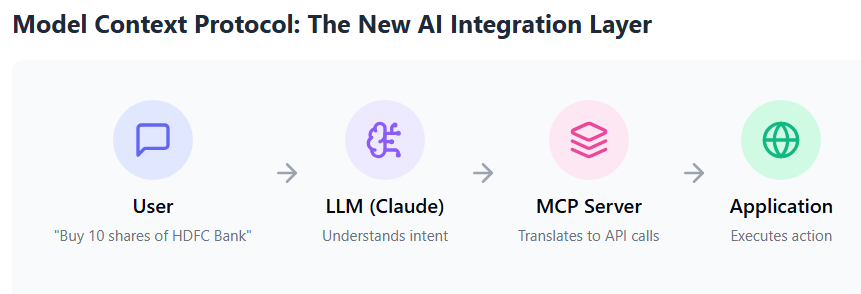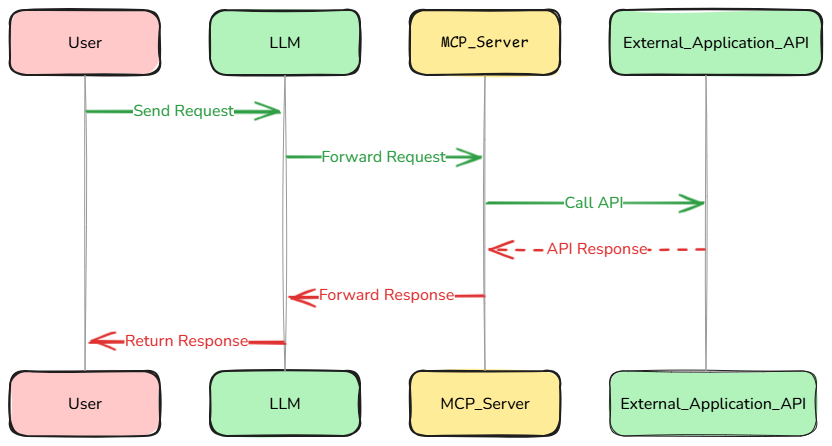Model Context Protocol: How LLMs Can Interact With Your Favorite Apps
Have you ever wished you could simply ask an AI to buy stocks, search your Google Drive, or push code to GitHub for you? This capability is becoming a reality thanks to a new protocol introduced by Anthropic called the Model Context Protocol (MCP). This innovation bridges the gap between large language models (LLMs) like Claude and traditional web applications, opening up exciting new interaction possibilities.
What Exactly Is Model Context Protocol?
Model Context Protocol, or MCP, is an intermediary layer that allows LLMs to communicate with external applications and services. In essence, it provides “context” to AI models about how to interact with specific applications, enabling them to take actions on your behalf through natural language instructions.
The name tells us exactly what it does:
Model: The AI language model (like Claude)
Context: Information about external applications
Protocol: A standardized communication method

How MCP Works as an Intermediary Layer
MCP servers act as translators between LLMs and traditional applications:

The MCP server contains all the necessary logic to:
Interpret natural language requests from the LLM
Convert them to appropriate API calls
Handle authentication securely
Return results back to the LLM
This creates a powerful new interaction model where users can express their intent in natural language, and the application executes the appropriate actions behind the scenes.
The Growing Ecosystem of MCP Servers
The protocol is gaining significant traction. A growing repository of MCP server implementations exists at with integrations for:
modelcontextprotocol/servers: Model Context Protocol Servers
This collection allows Claude (and potentially other LLMs that adopt MCP) to interact with a wide range of services through a standardized protocol.
Real-World Applications: Beyond Stock Trading
While the example in our transcript focuses on stock trading with Zerodha, the applications of MCP extend much further:
Smart Home Control: “Turn off the lights in my bedroom”
Content Management: “Find my presentation from last month and update the Q3 figures”
Development Workflows: “Check the status of my pull requests and merge the ones approved by at least two reviewers”
Data Analysis: “Pull last quarter’s sales data and show me which products underperformed”
The power lies in combining an LLM’s natural language understanding with specific application capabilities.
The Future of LLM-App Interactions
MCP represents a significant shift in how we might interact with applications in the future. Rather than navigating through interfaces designed for human interaction, we can simply state our intentions and let AI handle the implementation details.
This has several important implications:
Accessibility improvements: People who struggle with complex interfaces can use natural language instead
Efficiency gains: Completing multi-step workflows with single instructions
New interaction paradigms: Interfaces designed primarily for AI intermediaries rather than direct human manipulation
However, challenges remain. MCP is currently an Anthropic-introduced protocol, and broader adoption by other LLM providers will be necessary for it to become a universal standard.
Building Your Own MCP Server
For developers interested in exposing their applications to LLMs, creating an MCP server involves defining:
The capabilities you want to expose (called “tools” in MCP terminology)
The resources these tools operate on
The authentication mechanisms required
This creates a standardized way for LLMs to understand what your application can do and how to interact with it.
Beyond The Obvious: Why This Matters
The significance of MCP extends beyond convenience. It represents a fundamental shift in how we might design software interfaces in the future:
Accessibility revolution: Complex tools become accessible to people who understand their domain but not the technical implementation.
Expertise compression: Years of learning specialized interfaces could be replaced with domain knowledge plus natural language.
Focus on intent: We shift from “how to accomplish a task” to simply expressing what we want to achieve.
Conclusion
Model Context Protocol represents an important step toward a future where AI serves as an intelligent intermediary between humans and software. By standardizing how LLMs interact with external applications, MCP creates new possibilities for natural language interfaces across virtually any digital service.
While we’re still in the early days of this technology, the rapidly growing ecosystem of MCP servers suggests strong interest in this approach. Whether you’re looking to interact with existing services or expose your own application’s functionality to LLMs, MCP provides a structured framework to make that possible.
The next time you find yourself clicking through a complex interface, remember that soon you might simply be able to ask an AI to handle it for you — thanks to innovations like Model Context Protocol.
Join Yash on Peerlist!
Join amazing folks like Yash and thousands of other people in tech.
Create ProfileJoin with Yash’s personal invite link.
1
14
1